AT4
The AT4 (also AT-4)[8] is an 84-mm unguided, portable, single-shot recoilless smoothbore anti-tank weapon built in Sweden by Saab Bofors Dynamics (previously Bofors Anti-Armour Systems).[9] Saab has had considerable sales success with the AT4, making it one of the most common light anti-tank weapons in the world.
| AT4 AT4 CS, AT4-CS, AT-4CS | |
|---|---|
 U.S.-spec AT-4 | |
| Type | Anti-tank weapon |
| Place of origin | Sweden |
| Service history | |
| In service | 1987–present |
| Used by | See Operators below |
| Wars |
|
| Production history | |
| Manufacturer | Saab Bofors Dynamics |
| Unit cost | US$1,480.64[4] |
| No. built | 600,000+[5] |
| Variants | AT-4 CS |
| Specifications | |
| Mass | 6.7 kg (14.8 lb) (AT4)[6] 8 kg (18 lb) (AT4-CS) |
| Length | 102 cm (40 in)[6] |
| Muzzle velocity | 290 m/s (950 ft/s)[7] |
| Effective firing range | 300 m (point target)[6] |
| Maximum firing range | 500 m (area target) 2,100 m (maximum) |
| Sights | Iron sights, optional night vision unit |
| Filling | Octol |
| Filling weight | 440 g HEAT (High Explosive Anti-Tank round) |
| Prototype AT4 Sweden tested 1981/82 | |
The AT4 is intended to give infantry units a means to destroy or disable armoured vehicles and fortifications, although it is generally ineffective against current modern main battle tanks (MBT). The launcher and projectile are manufactured prepacked and issued as a single unit of ammunition, with the launcher discarded after a single use.
Development
The AT4 is a development of the 74-mm Pansarskott m/68[10] (Miniman), adopted by the Swedish Army in the late 1960s. Like the m/68, the AT4 was designed by Förenade Fabriksverken (FFV) and manufactured at their facility at Zakrisdal, Karlstad, Sweden.[9] FFV began research in a replacement for the m/68 in 1976, deliberately designing an individual anti-armor weapon that would not be able to defeat the heavy armour protection of MBTs (main battle tanks) in frontal engagements, believing that to be counterproductive. The AT4 was designed as a weapon to engage medium to light armoured vehicles from any direction, MBTs from the sides or rear, and as an assault weapon against buildings and fortifications. FFV also had the design goal of a weapon that was simple to use, rugged, and far more accurate than previous individual antiarmor weapons against moving targets. Another key requirement was that the AT4 not only be able to penetrate armour, but also have a devastating beyond-armour effect after penetration. FFV and the Swedish Army began the first evaluation firings of the prototype AT4s in the spring of 1981 with 100 tested by early 1982.[11]
Even before the AT4 had been adopted by Sweden, it was entered into a US Army competition for a new anti-tank weapon mandated by Congress in 1982 when the FGR-17 Viper failed as a replacement for the M72 LAW. Six weapons were tested in 1983 by the US Army: the British LAW 80, the German Armbrust, the French APILAS, the Norwegian M72E4 (an upgraded M72 LAW), the US Viper (for baseline comparison purposes) and the Swedish AT4. The US Army reported to Congress in November 1983 that the FFV AT4 came the closest to meeting all the major requirements established to replace the M72 LAW,[12] with the Armbrust coming in second.[13]
Though very impressed with the simplicity and durability of the tested version of the AT4, the US Army saw some room for improvement, specifically the addition of rear and front bumpers on the launch tube and changes to the sights and slings. After these changes, the AT4 was adopted by the US Army as the Lightweight Multipurpose Weapon M136.[14] The Swedish Army also recognized these improvements and subsequently adopted the Americanized version of the AT4 as the Pansarskott m/86 (Pskott m/86), with the addition of a forward folding hand grip to help steady the AT4 when being aimed and fired. The forward folding grip is the only difference between the AT4 adopted by Sweden and the US Army version.
Due to the urban combat conditions that US military forces faced regularly during the Iraq War, the US Army Close Combat Systems manager in charge of purchases of the AT4 suspended orders for the standard version of the AT4 and US military forces are now only ordering the AT4 CS (Confined Space) version.[15]
Operation
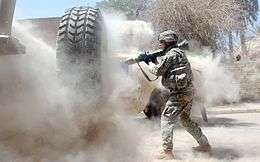
The AT4 may be considered a disposable, low-cost alternative to a Carl Gustaf recoilless rifle. The AT4 took many of its design features from the Carl Gustaf, which operates on the principle of a recoilless weapon, where the forward inertia of the projectile is balanced by the inertia of propellant gases ejecting from the rear of the barrel. But unlike the Carl Gustaf, which uses a heavier and more expensive steel tube with rifling,[16] the disposable AT4 design greatly reduces manufacturing costs by using a reinforced smoothbore fiberglass outer tube. Being a disposable gun also allows for lighter and cheaper construction. In a single-use disposable gun, the barrel only needs to be able to contain a single pressure spike when firing, when it can be disposed of, even if it is ruined, burnt-out and strained, unlike traditional guns which are required to survive many pressure spikes without failure and thus need to be strongly overbuilt and made of heat-proof materials. Pressures are also kept quite low compared to many traditional guns. This lightweight and thin barrel and low pressure, combined with the almost complete lack of recoil, means that relatively large projectiles (comparable to those found in mortars and artillery systems) can be utilised, which would otherwise be impossible in a man-portable weapon.
In the system originally developed by FFV for the Carl Gustaf, a plastic blowout plug is placed at the center rear of the shell casing containing the projectile and propellant, which itself is enclosed in the AT4 outer tube. When the gases build up to the correct pressure level, the blowout plug disintegrates, allowing the proper amount of gases to be vented to the rear, balancing the propellant gases pushing the projectile forward.
The AT4 uses a unique method developed earlier by FFV and adopted for the AT4: the spring-loaded firing rod is located down the side of the outer tube, with the firing pin at the rear of the tube. When released, the firing pin strikes a primer located in the side of the casing's rim.
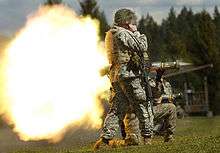
The disadvantage of the recoilless design is that it creates a large back blast area behind the weapon, which can cause severe burns and overpressure injuries to friendly personnel in the vicinity of the user and sometimes even to the users themselves, especially in confined spaces. The back blast may also reveal the user's position to the enemy. The problem of back blast was solved with the AT4-CS (Confined Space) version, specially designed for urban warfare. This version uses a saltwater countermass in the rear of the launcher to absorb the back blast; the resulting spray captures and dramatically slows down the pressure wave, allowing troops to fire from enclosed areas. The AT4-CS version also reduced its muzzle velocity from the original 290 m/s to 220 m/s as part of its effort to be user-safe in a confined space, making the AT4-CS version more difficult to use as the drop is more pronounced. The effectiveness of the HEAT warhead is not dependent on speed.
To fire, the gunner first removes the safety pin located at the rear of the tube, which unblocks the firing rod. He then takes a firing position ensuring that no one is present in the back blast area. If firing from the prone position, he must also place his legs well to the side to avoid burning himself. Then the gunner moves back the front and rear sight covers, allowing the sights to pop up into their firing positions. The AT4 has iron sights that were originally developed for the cancelled Viper, and are similar in concept and use to those on assault rifles.[17] He then removes the first of two safeties by moving the firing rod cocking lever (located on the left side) forward and then over the top to the right side. The gunner takes aim, while at the same time holding down the red safety lever located in front of the cocking lever, and then fires by pressing forward the red firing button with his right thumb. Both the red safety lever and the firing button must be pressed down at the same time to fire the AT4. The red firing button has a similar resistance to the trigger pull of a rifle, so the gunner does not have to jab at the firing button, which could throw his aim off.
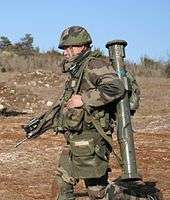
After firing, the AT4 is discarded. Unlike the heavier Carl Gustaf, the AT4 outer tube is built to take the stress of just one firing; it is not reusable and cannot be reloaded.
The AT4 can mount an optical night sight on a removable fixture. In US military use, the launcher can be fitted with the AN/PAQ-4C, AN/PEQ-2, or the AN/PAS-13 night sights.
The AT4 requires little training and is quite simple to use, making it suitable for general issue. However, as the cost of each launcher makes regular live-fire training very expensive, practice versions exist that are identical in operation but fire reloadable 9×19mm or 20mm tracer ammunition. Both practice cartridges are unique to their respective weapons, with their trajectory matched to that of the live round. The 20mm version also has a recoilless weapon effect with the same high noise and back blast as the AT4 firing and is favoured by the Swedish army because of the added realism of the back blast as compared to the "plonk" sound of the 9mm round (similar to the sound of a finger tapping on an empty can).
Specifications
- Length: 101.6 cm (40 in.)
- Weight: 6.7 kg (14.77 pounds)
- Bore diameter: 84 mm
- Maximum effective range: 300 metres (328 yards), although it has been used in excess of 500 meters (547 yards) for area fire.
- Penetration: 420 mm (15.7 inches) of rolled homogeneous armour (RHA; also see below)
- Time of flight (to 250 metres, or 273 yards): less than 1 second
- Muzzle velocity: 290 metres (950 ft) per second
- Operating temperature: −40 to +60 °C (−40 to +140 °F)
- Ammunition: fin-stabilized projectile with HEAT warhead
Projectiles
There are several different projectiles for the AT4. Note that because the AT4 is a one-shot weapon, projectiles are preloaded into the launcher tubes.[9]
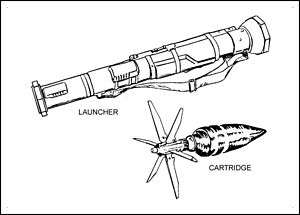
- HEAT (High Explosive Anti-Tank)
- The HEAT projectile can penetrate up to 420 mm (16.5 inches) of RHA with beyond-armour effect.[18]
- HEDP 502 (High Explosive Dual Purpose)[9][19]
- For use against bunkers, buildings, enemy personnel in the open and light armour. The projectile can be set to detonate on impact or with a slightly delayed detonation. The heavier nose cap allows for the HEDP projectile to either penetrate light walls or windows and then explode, or be "skipped" off the ground for an airburst. For use against light armour, there is a smaller cone HEAT warhead with 150 mm (5.9 inches) of penetration against RHA.
- HP (High Penetration)
- Extra high penetration ability (up to 500 mm to 600 mm (19.7 inches to 23.6 inches) of RHA.)
- AST (Anti Structure Tandem-warheads)
- Designed for urban warfare where a projectile heavier than the HEDP AT4 is needed. This projectile combines a HEAT warhead with a shallow cone, which results in low penetration but produces a wide hole, with a follow-through high-blast warhead. It has two settings: one for destroying bunkers and one for mouse-holing a building wall for combat entry.[20]
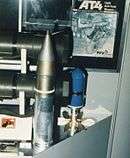
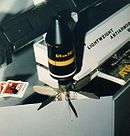
- ER (Extended Range)
- Anti-armor version with HEAT warhead that extends range from 300 m to 600 m.[21]
Variants
- M136 AT4
- American version with modified launch tube bumpers, sights and slings.[22]
- AT8 (Bunker-Busting)
- A version of the AT4 where the standard HEAT projectile is replaced with the bunker-busting warhead developed for the SMAW. No orders were ever placed.[23]
- AT12-T
- In the early 1990s, there were tests of a tandem charge 120-mm version (Bofors AT 12-T) that would be able to penetrate the front armour of any modern main battle tank. However, the project was cancelled due to the dissolution of the Soviet Union and the subsequent cuts in Western defence budgets.
Operators





.svg.png)

























See also
- ALAC (Arma Leve Anticarro)
- Alcotan-100
- APILAS
- B-300
- Carl Gustaf recoilless rifle there is some crossover with warhead types between the two systems. Both are 84mm
- DZJ-08
- LAW 80
- MARA (anti-tank weapon)
- MATADOR
- Panzerfaust 3
- RPG-76 Komar
- RPG-75
- Urban Assault Weapon
- M141 Bunker Defeat Munition
- Kestrel
References and notes
- Vapenexport (PDF), SE: Svenskafreds.
- Richard, Christophe (2014). "Battle of Abidjan: accurate and timely fires" (PDF). Fantassins. No. 32. p. 28. Archived from the original (PDF) on 15 December 2018. Retrieved 13 December 2018.
- Capdeville, Thibault (Spring 2014). "Infantry units fires during OP Serval" (PDF). Fantassins. No. 32. pp. 55–58. Archived from the original (PDF) on 15 December 2018. Retrieved 13 December 2018.
- M136 AT4, FAS, archived from the original on 3 April 2007, retrieved 3 April 2007.
- Kemp, Ian (April–May 2006), "The law gets tougher: the shoulder-launched light anti-armour weapon has evolved to become a multipurpose assault weapon much in demand for asymmetric warfare", Armada International, ISSN 0252-9793.
- McManners, Hugh (2003). Ultimate Special Forces. DK Publishing. ISBN 0-7894-9973-8.
- Owen, William F. (2007). "Light Anti-Armour Weapons: Anti-Everything?" (PDF). Asian Military Review. Archived from the original (PDF) on 7 July 2011. Retrieved 12 May 2010.
- The designation AT-4 is an alpha-phonetic word play on the weapon's role (AT = "Anti-Tank") and calibre of 84 mm. Hewish, Mark, "FFV's Lightweight AT4, first of a new family of Swedish anti-armour weapons" International Defense Review, May 1980, p. 70.
- "AT4 Light Anti-Armour Weapon". Army Technology. Archived from the original on 7 May 2016. Retrieved 3 May 2016.
- Pansarskott is a Swedish term that roughly translates to "Armour Shot."
- International Defense Review, May 1980, p. 71.
- The French APILAS was the only tested weapon that had the maximum penetration to defeat the frontal armor of the new Russian T-72 MBT, but it was rejected due to its weight and size.
- The Armbrust, while an impressive weapon with its almost total lack of launch signature, which enabled it to be fired from enclosed spaces, was rejected due to higher cost and lack of effective range against moving targets.
- The U.S. Army had so much grief in the early 1980s from various committee members of the U.S. Congress over the M72 LAW being officially referred to in manuals as a Light Antitank Weapon that they named the AT4 to make sure no member of Congress could question that again.
- John Antal. "Packing a Punch: America's Man-Portable Antitank Weapons". page 90. Military Technology. March 2010. ISSN 0722-3226.
- Until the 1980s the Carl Gustaf was constructed of high-alloy steel, but later versions used a thin steel liner containing the rifling, strengthened by a carbon fiber outer sleeve.
- FFV and the Swedish Army were so impressed by these sights that they adopted them for their AT4s; while adequate during the day, the original plastic sights were difficult to see at night or under low light conditions.
- History Channel, Lock N' Load With R. Lee Ermey, Rockets episode, aired 23 October 2009.
- the complete disposable launcher and HEDP projectile is referred to by the manufacture in brochures as the LMAW – i.e., light multipurpose-assault weapon – see external links for link on early photos and press releases for further information on brochure
- "2008 SAAB video on AT4 versions including new multipurpose warhead for urban combat". YouTube. Archived from the original on 18 October 2014. Retrieved 11 October 2014.
- Saab to integrate new projectile variants for disposable shoulder-launched rocket system Archived 24 December 2016 at the Wayback Machine - Janes.com, 11 June 2014
- "AT4 Light Anti-Armour Weapon - Army Technology". Archived from the original on 31 July 2018.
- Jane's Infantry Weapons 1995–96-page 220. The reference refers to Allaint Techsystems as the manufacture, but they soon after were acquired by Honeywell. The SMAW-D offered by Talley was chosen for the U.S. Army program that the AT4 entered. See external images at the SMAW-D link for an arms brochure on the FFV AT8
- "Carl Gustaf , AT-4CS y fusiles Steyr HS.50 M1 para el Ejército Argentino". 27 October 2017. Archived from the original on 29 October 2017. Retrieved 29 October 2017.
- "La Infantería de Marina adquirió armamento antitanque descartable". Archived from the original on 2 November 2010. Retrieved 25 October 2010.
- Jones, Richard D (27 January 2009), Infantry Weapons 2009/2010 (35 ed.), Jane's Information, ISBN 978-0-7106-2869-5.
- The World Defence Almanac, 2000, ISSN 0722-3226.
- "ESTPLA-7 täiustab sidesüsteemi". mile.ee. 11 September 2003. Archived from the original on 20 July 2011. Retrieved 20 May 2010..
- Replaced the APILAS: AT 4 CS – L'arme anti blindé lourd AT 4 CS – The Armoured Heavy anti gun, France: Ministry of Defense, archived from the original on 8 January 2014, retrieved 29 June 2013.
- "Swedish weapons in the Iraqi military?", Radio Sweden, archived from the original on 19 February 2011, retrieved 18 November 2010
- Vining, Miles (19 June 2018). "ISOF Arms & Equipment Part 4 – Grenade Launchers & Anti-Armour Weapons". armamentresearch.com. Archived from the original on 28 July 2018. Retrieved 31 July 2018.
- https://web.archive.org/web/20191108181107/https://pbs.twimg.com/media/EIsZINeWsAMeI-J?format=jpg&name=large
- The World Defence Almanac, 2010, p. 172, ISSN 0722-3226.
- Kahwaji, Riad (13 November 2007). "Lebanon: Foreign Arms Vital to Hizbollah Fight" (JPEG). Defense News. Archived from the original on 17 July 2011. Retrieved 25 January 2009.
- "Lietuvos kariuomenė :: Ginkluotė ir karinė technika » Granatsvaidžiai ir prieštankiniai ginklai » Prieštankinis granatsvaidis AT-4". Archived from the original on 9 October 2014. Retrieved 11 October 2014.
- The World Defence Almanac, 2005, p. 105, ISSN 0722-3226.
- "Polish Army Photogallery" (26). Polish Ministry of Defence. Archived from the original on 17 July 2011. Retrieved 26 April 2010. Cite journal requires
|journal=(help) - "Modernizing and Equiping the Army". Department of the Army Historical Summary, FY. United States Army Center of Military History. 1987. p. 43. CMH Pub 101-19. Archived from the original on 21 September 2010. Retrieved 13 August 2010.
- "Global Security - News and Defence Headlines - IHS Jane's 360". IHS Jane's 360. Archived from the original on 10 March 2011. Retrieved 11 October 2014.
- "Presentan video del ELN con armas de Cararabo - Internacional - EL UNIVERSAL". www.eluniversal.com. Archived from the original on 8 December 2015. Retrieved 29 November 2015.
- "Colombia and Venezuela face off". GlobalPost. Archived from the original on 18 October 2014. Retrieved 11 October 2014.
External links
| Wikimedia Commons has media related to AT-4. |
- Official site for the AT4, covering the different versions of AT4
- Saab AT4 PDF
- AT4 – Saab Bofors Dynamics video of various AT4 versions
- AT4 Information Page – Modern Firearms
- Swedish article on AT4 translated to English
- M136 AT4 – Global Security
- AT4 article with early photos and press releases and ads
- U.S. Army field manual 3–23.25
- Brazilian newspaper recorded a AT-4 at Rocinha slum (translated to English)